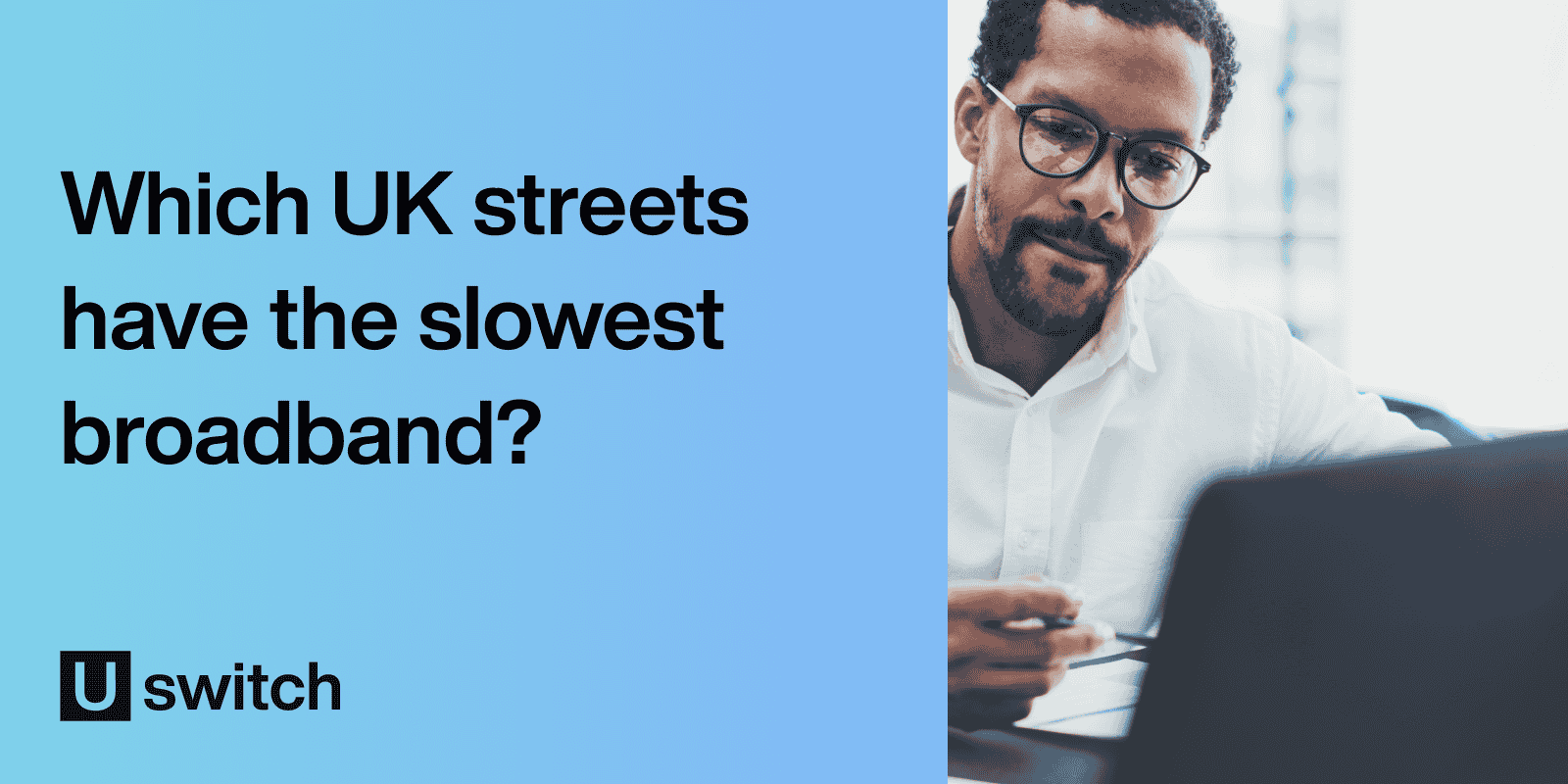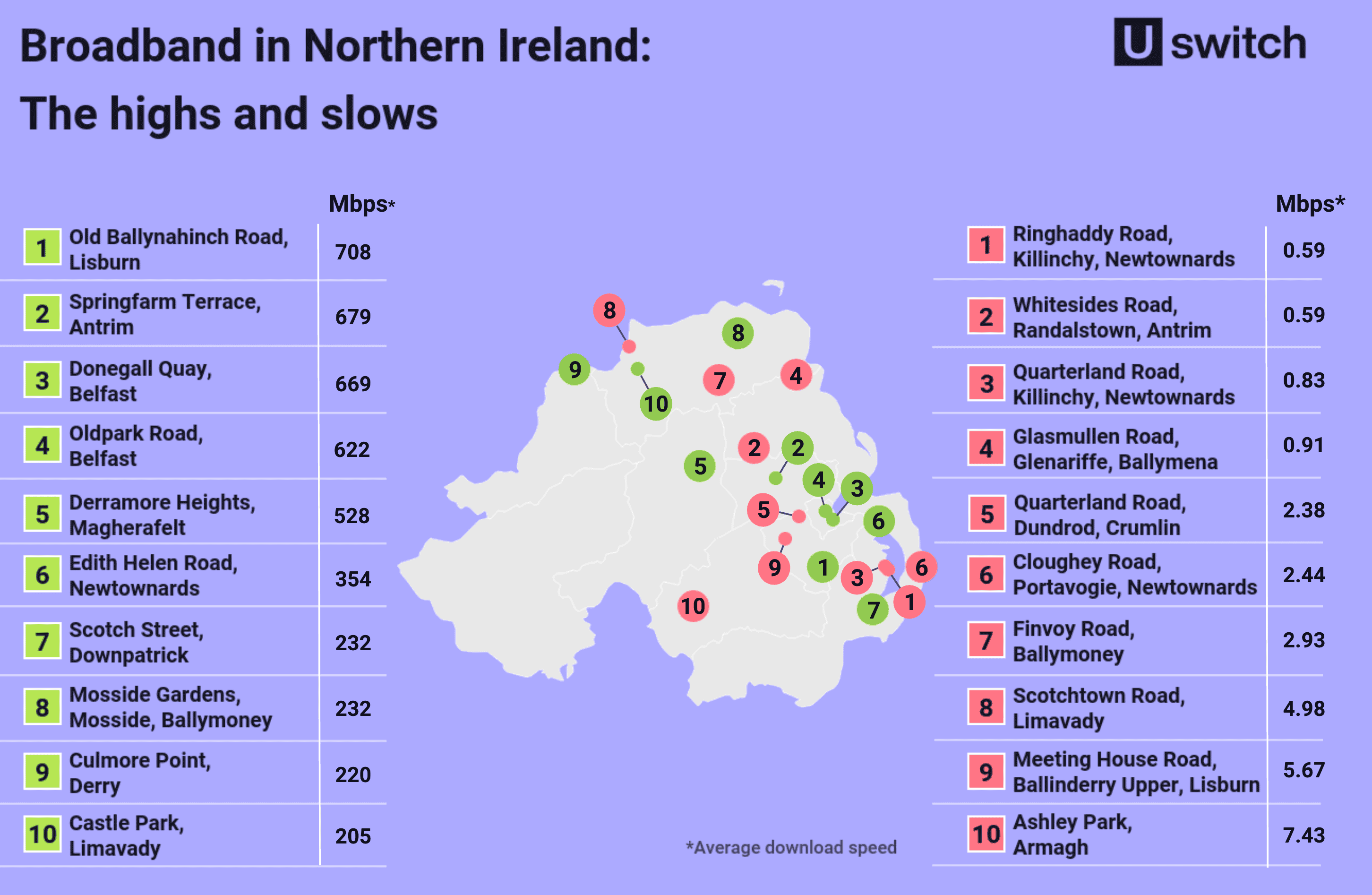- Uswitch.com>
- Broadband>
- Guides>
- Which UK streets have the slowest broadband speed?
Which UK streets have the slowest broadband speed?

Every December, Uswitch analyses all of its broadband speed tests that were run throughout the year, to find out which areas of the UK have the fastest internet speeds and which areas have the slowest.
This year, it’s revealed some surprising results. The UK’s slowest streets aren’t always tucked away in the far corners of the country, and the fastest broadband speeds we record are often in unsuspected areas.
For example, big cities like London and Manchester are almost absent from the top 10 fastest streets in Britain in 2021, and average broadband speeds still vary drastically from one postcode to the next.
Find out which streets have the UK’s slowest and fastest internet speeds.
The slowest street in the UK is in Crewe
This year, the street with the slowest broadband speed is Wistaston Road in Crewe, where residents are somehow managing to get by with average broadband speeds of just 0.25Mbps.
In a time when having a strong broadband connection is more vital than ever, speeds at this level are completely unworkable for any household. At this speed, it would take the unfortunate residents of Wistaston Road over two-and-a-half days to download a two-hour HD film, and almost 24 hours to download a 45-minute HD TV show.
By contrast, the people who live on Britain’s fastest street for broadband, Haul Fryn in Birchgrove, Swansea, would only have to wait about a minute to download the same film or a mere 24 seconds to download the same show.
Sluggish-paced Wistaston Road is a staggering 3,567 times slower than Haul Fryn, where average speeds reached 882.03Mbps over the past year. The difference between the fastest and slowest is astonishing, and has increased dramatically since 2019, when the worst street was only 830 times slower than the fastest. This suggests that the UK’s digital divide is growing with the rollout of full fibre broadband (FTTP) that has now brought ultrafast speeds to 24% of the country.
Ernest Doku, broadband expert at Uswitch.com, says:
“Britain’s broadband keeps getting quicker every year, but parts of the country continue to be left behind.
“Residents of this year’s fastest street, Haul Fryn, could download a film in 47 seconds - where it would take those living in Wistaston Road more than 48 hours to do the same thing.
“At a time when so many of us rely on our broadband for work, streaming films and TV, and gaming, it’s hard to imagine how frustrating such a slow connection must be."
The 10 streets with the slowest broadband in the UK
Hover over the points in our graphic with your mouse — or tap them if you’re on your mobile — to see where the UK’s slowest streets are and what speed they’re getting.
What’s interesting is that ultrafast broadband services are at least partially available to more than half of the slowest streets in the UK.
This means that if customers in these areas decided to switch to an ultrafast broadband provider, they could get access to broadband speeds of at least 100Mbps. In short, they could be enjoying speeds that are potentially hundreds of times faster than those they’re struggling with at the moment.
Ernest went on to say,
“It’s great to witness the increased uptake of ultrafast broadband, but we don’t want to see large swathes of the country left behind on shoddy connections that aren’t cutting it for modern life.
“Initiatives like the Universal Service Obligation and Project Gigabit are helping improve connections at both ends of the spectrum, but there is a lot more to be done so consumers don’t get left behind.
“Of the ten slowest streets, nine could have access to faster broadband, so we urge residents there — and anyone else unhappy with their broadband speeds — to do a quick search online to see what speeds they could be getting with another provider.”
The 10 streets with the fastest broadband in the UK
Hover over the points in our graphic with your mouse — or tap them if you’re on your mobile — to see where the UK’s fastest streets are and what speed they’re getting.
The fastest street for broadband in the UK is Haul Fryn in Birchgrove, Swansea, where average speeds reached 882Mbps over the past year. Second and third place went to Grange Road, Ilford and Dalesgate Close, Littleover, Derby, both of which had average broadband speeds of over 850Mbps.
While Haul Fryn is the clear winner, it’s worth highlighting that last year, the top three fastest streets maxed out at 639Mbps, 568Mbps and 563Mbps. That’s a staggering jump in the fastest broadband available in well-connected regions of the UK.
Notably, Dale Lane and Old Ballynahinch Road are the only streets to keep a place in the UK’s top ten fastest street rankings from our 2020 study. This goes to show that ultrafast broadband is rapidly expanding across the UK, with thousands of streets having full fibre installed at any given time. So it might not be as long as you think until your street gets the same.
What's the average broadband speed in the UK?
According to Ofcom's latest internet speeds report, the average home broadband download speed in March 2021 was 79.1Mbps. This is despite the fact that most people can still only access a maximum speed of about 70Mbps.
The number has largely been driven by the increasing rollout of ultrafast broadband and full fibre across the country, which provide internet speeds of 100Mbps and much higher. 24% of the UK can now access these connections, so this would explain why the average is faster than what most properties can get.
Despite this, broadband statistics show that the average broadband speed is increasing year-on-year. In 2017, the average download speed stood at 36Mbps—an increase of 43.1Mbps in five years.
What is a good broadband speed in the UK?
Even though the average broadband speed is higher than most connections, it doesn't necessarily mean you're falling behind if your own speed is slightly slower.
Most households can still get on without any issues if they have a superfast fibre speed of 30-70Mbps, since it'll be able to handle multiple people streaming TV at once, and at least two people working from home.
You'd only really start to notice a strain if you have many people in your household all trying to stream the highest quality TV, or constantly download very heavy files, all at the same time. Especially if you're trying to work from home while all that is going on too.
However, our demand for broadband is increasing quite rapidly, and soon these speeds won't cut it for most households. With more gadgets entering the home, more appliances turning 'smart', working from home becoming a normality and higher quality streaming and gaming, many households soon won't be able to deal with this level of speed.
That's why the UK is ramping up its ultrafast and gigabit broadband rollout - because it'll help to future-proof our homes in time for all of the extra internet we'll be using in the next few years.
Take a look at our broadband speed download time calculator to see how much time a faster internet connection could save you.
Slowest streets across the UK
Here are some of the slowest streets for broadband in different areas of the country, and how they compare to their top-speed counterparts.
Fastest and slowest internet speeds in Scotland
Scotland's slowest street is Grant Road, which is based in Banchory, Aberdeenshire. Its average download speed is 0.28Mbps, so it also features in the ten slowest streets in the entire country.
The country’s fastest street is Murrayfield Terrace in Brannockburn, Stirling, which clocks in at 665Mbps. That’s over 2,000 times faster than Grant Road!
Fastest and slowest internet speeds in Wales
Llys Tripp in Gwaelod-y-Garth, Cardiff, has Wales' slowest broadband speed, only reaching 0.34Mbps on average in the speed tests taken by its residents. It's also one of the ten slowest streets in the whole of the UK.
The fastest street in Wales is the aforementioned Haul Fryn — the fastest street in the UK this year.
Fastest and slowest internet speeds in Northern Ireland
Northern Ireland is the only devolved nation not to feature in the UK's ten slowest streets. And although it’s a focus for many full fibre providers in the UK, ultrafast broadband speeds are still a long way from becoming nationwide.
Just like last year, its slowest street for broadband is Ringhaddy Road in Killinchy, Newtownards. But the silver lining for 2021 is that it’s no longer in the top-ten slowest streets in the country. Old Ballynahinch Road continues to impress in our annual chart, taking the number one spot in Northern Ireland once again in 2021.
Find broadband deals in Belfast.
Fastest and slowest internet speeds in London
London’s slowest street, South Park Crescent, is part of the ten slowest streets in the entire UK, despite being in a busy urban area like Lewisham. This illustrates perfectly how built-up urban neighbourhoods can still struggle to get a reliable internet speed, just like remote properties in the countryside.
By comparison, at 877Mbps, the Big Smoke’s *fastest* street is Grange Road in Ilford, Redbridge — the second fastest street in the UK. Mallards Road in Woodford Green takes second place and The Underwood in Greenwich takes the position as the third fastest broadband in London. Regular charter Central Park Road in Newham has fallen out of the top-ten for the first time since 2018.
Fastest and slowest internet speeds in the West Midlands
Cornwall Road in Wolverhampton has the West Midlands' slowest broadband speed, at just 0.4Mbps on average. This means it’s tied with the 9th and 10th slowest streets in the UK. Wilson Gardens in Malvern is the West Midlands’ fastest street, with an average internet speed of 511Mbps.
Fastest and slowest internet speeds in the North West
As the slowest street in the UK, Wistaston Road, is based in Crewe, it naturally also takes the bottom spot for the North West this year. West Gate in Fleetwood is the North West’s fastest street at 841Mbps, and is the UK’s fourth fastest street. This shows a very wide gap for the North West, with the fastest street being over 3,300 times faster than the slowest.
Faster broadband is closer than you think
For many, just knowing what broadband connections are available in your area could save you hours of internet woes. Of the ten slowest streets, nine of them can access much faster speeds of at least 30Mbps, with some even being able to get the ultrafast speeds seen in the top ten *fastest* UK streets.
It’s another sign that many people simply aren’t aware that they can actually be on a much better broadband speed for their household. This can unlock a range of benefits, like better productivity when working from home, multiple family members being able to stream and game at the same time, and improved picture quality on the things you watch.
If all of these streets can get a much better internet connection than what they’re currently on, there’s a very good chance you could also be enjoying much faster speeds than your current connection. So if you’re looking for a faster service, compare broadband deals with Uswitch to see what speeds you could be getting.
Testing your broadband speed
The Uswitch broadband speed test measures the current internet speed your connected device is receiving. In order to accurately measure your home broadband speed, you need to be connected to your Wi-Fi router and ideally have a clear view of it before running the test.
It also requires a postcode to be entered before speeds are measured. We do this so you can see the average speed other people in your postcode usually get — which you can use to decide whether you should be on a faster connection or not. If you think you should be, you can learn how to switch broadband providers with our guide.
The postcode data also lets us compare the average speed street-by-street across the UK, and that information is what gives us our fastest and slowest streets.
Over 275,000 Uswitch speed tests were run in the last 12 months. That’s not quite the number we saw in 2020, when people started spending a lot more time at home, and broadband speed became a lot more important for working. But it’s still more than double the number we saw in 2019, which was just 122,000. Which makes sense, as many people still regularly work from home and TV streaming is more popular than ever.
But despite the fact that superfast broadband (downloads speeds of 30Mbps or more) is available to over 96% of the country, a recent Uswitch survey found that 40% didn’t know that they could access those speeds in their local area.
Not sure what internet speed you’re currently getting at home? Measure it with the Uswitch broadband speed test today.



